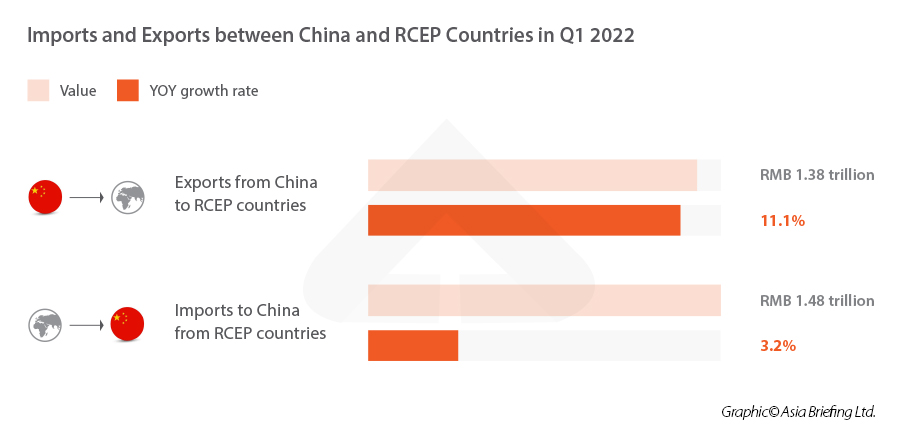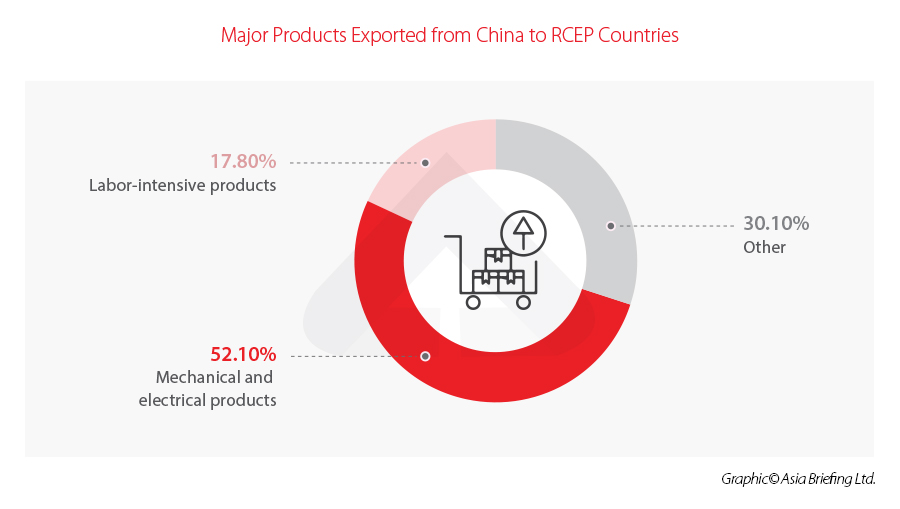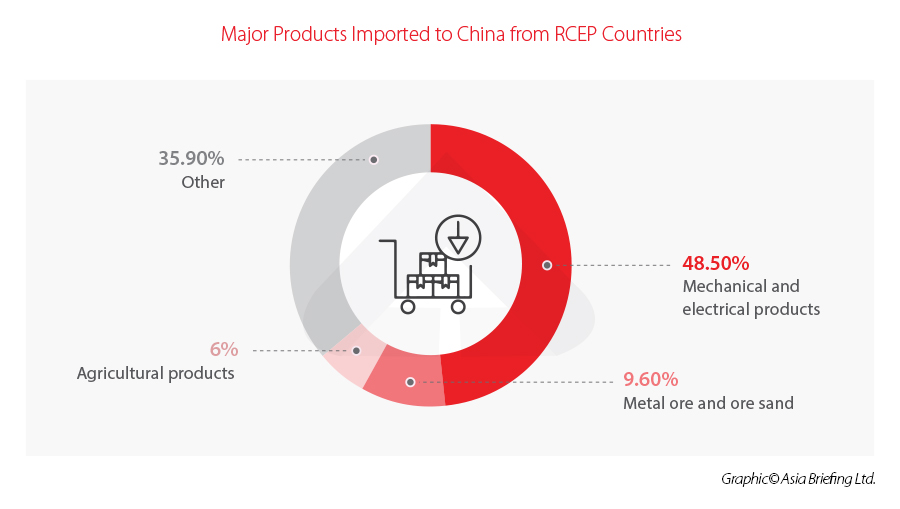How the RCEP Has Benefitted China: Initial Findings from 2022
The Regional Comprehensive Economic Partnership (RCEP) came into effect January 1, 2022. Data from the first quarter of 2022 show that China trade with member countries expanded 6.9 percent year-on-year to RMB 2.86 trillion (approx. US$448.6 billion). RCEP allows China to further leverage its trade potential to secure greater market access in the region. Key beneficiaries include mechanical and electrical product segments, the e-commerce industry, and small and medium-sized enterprises (SMEs).
What is the RCEP?
The RCEP, covering about one third of the world’s population and GDP, represents the world’s largest free trade agreement to date. The trade pact, signed by 15 Asia-Pacific countries – China, Japan, South Korea, New Zealand, Australia, and the 10 ASEAN member states – entered into force at the start of 2022. As of date, the agreement is effective for 12 of its 15 signatories (Indonesia, Myanmar, and the Philippines are yet to rectify the treaty).
The RCEP aims to remove tariffs on at least 90 percent of the goods traded among member countries – over the 20 years from coming into effect. It will promote free trade, reinforce industrial and supply chains, eliminate tariffs, and open up services and investments to expedite regional economic recovery from the pandemic. Under RCEP, China has established free trade relations with Japan for the first time in history, a move expected to boost economic integration and trade relations between the two countries.
The RCEP holds great significance for China and for foreign investors. The pact brings huge import-export opportunities for China, encouraging enterprises to expand exports in which China has comparative advantages, and increase imports of key technologies, components, and raw materials. It will provide China with a more stable and solid connection with Asia-Pacific countries strategically.
A recap of the RCEP’s implementation in the first few months
2022 marks the start of the RCEP. Despite the pandemic, China’s trade with RCEP countries accounted for 30.4 percent of China’s total foreign trade value, reaching RMB 2.86 trillion (approx. US$448.6 billion), according to the General Administration of Customs (GAC). This statistic makes ASEAN China’s largest trading partner.
Exports and imports between China and RCEP members grew steadily and reached US$ 203 billion (RMB 1.38 trillion) and US$ 218 billion (RMB 1.48 trillion), respectively and representing 11.1 percent and 3.2 percent y-o-y increases. Breaking this down, mechanical and electrical products and labor-intensive products dominated exports, taking up 52.1 percent and 17.8 percent, respectively. Imports of mechanical and electrical products, metal ore and ore sand, and agricultural products accounted for 48.5 percent, 9.6 percent, and 6 percent, respectively. China also imported US$ 6.79 billion (RMB 46.02 billion) of agricultural products from ASEAN, up 14.1 percent y-o-y, accounting for 13.7 percent of the total value of China’s agricultural imports.
Imports and Exports between China and RCEP Countries in Q1 2022
Customs statistics also demonstrate that in the first quarter, Chinese enterprises benefitted a fair deal from membership to the RCEP – RMB 6.7 billion in imports with preferential tariff treatment worth RMB 130 million and RMB 37.1 billion in exports with preferential tariff treatment worth RMB 250 million. China issued 109,000 RCEP certificates to domestic companies, encouraging them to take advantage of reduced tariffs when exporting goods.
Among the other 14 members, South Korea was China’s biggest trading partner. The value of bilateral trade rose 14.4 percent y-o-y to US $90.3 billion in the first quarter. Japan, which signed a free trade agreement with China for the first time through RCEP, was in the second place, with bilateral trade amounting to US $89.6 billion, up 3.8 percent y-o-y. China’s trade with 10 ASEAN members rose 10.9 percent to US $212.2 billion in the first quarter. The biggest increase in trade came from Cambodia, rising 39.1 percent, followed by Indonesia with 31.1 percent growth.
What does RCEP mean to China in the long term?
On January 26, 2022, China introduced a new guideline to promote high-quality implementation of the trade pact. It aims to guide local governments, industries, and enterprises to adapt to a more open regional market with fierce competition to realize high-quality economic development.
The pact’s emphasis on economic liberalization may push China for deeper reforms through high-level opening-up, which will in turn facilitate high-quality development. The deal may boost China’s efforts to stabilize foreign trade and investment, promote industrial upgrading, and help the country set up economic and trade rules that are compatible with international standards. High-end demand from overseas markets will also motivate Chinese enterprises to optimize products and services to eventually propel overall industrial upgrades in China.
Gradual elimination of tariffs means that the region is moving towards a large unified market with free flow of various production factors. This formation will reconfigure the supply and value chains in the region based on comparative advantages, beneficial to the exchange of goods, technology, and capital, as well as cross-border movement of people in the region. The intra-regional circulation will be more convenient and competitive as well. China’s complete industrial chains and technological strength will incorporate other countries into its “dual circulation.” Without tariffs, the effect of comparative advantage is likely to be enlarged.
The role of RMB settlement also sees tremendous internationalization potential under RCEP to support trade and investment and strengthen cooperation in high-end industrial chain and manufacturing projects. Replacing the US dollar, the current common trade currency, with RMB for cross-border settlements may further increase the efficiency of trade in the region.
Lastly, China’s involvement with RCEP couples with the Belt and Road Initiative (BRI) to promote regional economic growth and prosperity by creating infrastructure connectivity. In the first quarter, Chinese enterprises had made non-financial direct investment to BRI countries, which amounted to RMB 20.08 billion, accounting 20 percent in total overseas investment for the first time. The investment mainly went to Singapore, Indonesia, Malaysia, Vietnam, and other ASEAN countries.
What are the trends to watch under RCEP?
E-commerce
RCEP’s Chapter 12 targets to promote e-commerce as well as create a supportive legal, regulatory, and policy environment for it. The goal is to reduce import and export costs and better integrate the industrial and value chains in the region.
A new form of foreign trade, cross-border e-commerce has become an important driving force for stabilizing China’s imports and exports. In 2021, the import and export volume of China’s cross-border e-commerce totaled RMB 1.98 trillion (US $311.5 billion), up 15 percent y-o-y, among which the e-commerce exports stood at RMB 1.44 trillion, a 24.5 percent yearly increase.
Given the rapid growth of the digital economy, Chapter 12 is of interest to many for its relevance in cybersecurity, individual privacy, and national security. Two particularly striking aspects of Chapter 12 are its prohibitions against requirements for localized computer facilities and localized data. China, as an RCEP signatory, made its first-ever commitment, in principle, to binding prohibitions against the localization of data facilities and data, a significant departure from its long-standing hard sovereignty stance toward data.
Boost to SME stakeholders
RCEP will also boost the development of SMEs by providing important opportunities for SMEs to participate in regional and global value chains. The pact adopts a rule of “origin in the region” to facilitate regional supply chain management, increase intra-regional sourcing options, reduce transaction costs for enterprises, and integrate SMEs into regional trade and investment.
About Us
China Briefing is written and produced by Dezan Shira & Associates. The practice assists foreign investors into China and has done so since 1992 through offices in Beijing, Tianjin, Dalian, Qingdao, Shanghai, Hangzhou, Ningbo, Suzhou, Guangzhou, Dongguan, Zhongshan, Shenzhen, and Hong Kong. Please contact the firm for assistance in China at china@dezshira.com.
Dezan Shira & Associates has offices in Vietnam, Indonesia, Singapore, United States, Germany, Italy, India, and Russia, in addition to our trade research facilities along the Belt & Road Initiative. We also have partner firms assisting foreign investors in The Philippines, Malaysia, Thailand, Bangladesh.
- Previous Article China Annual IIT Reconciliation – Your Tax Refund FAQs Answered
- Next Article Belt and Road Weekly Investor Intelligence #81












